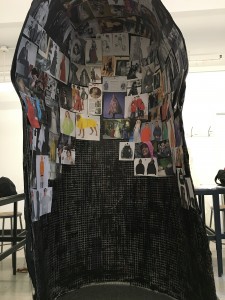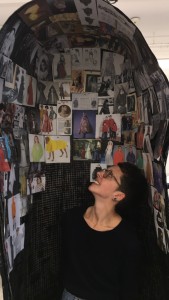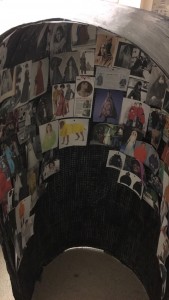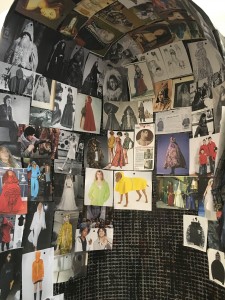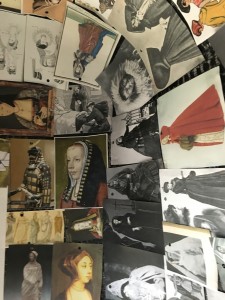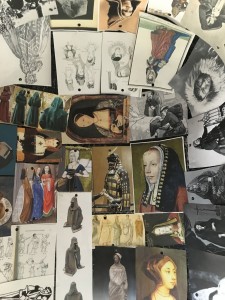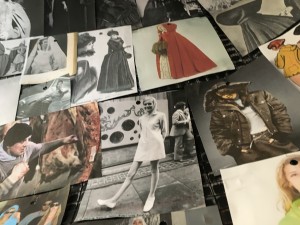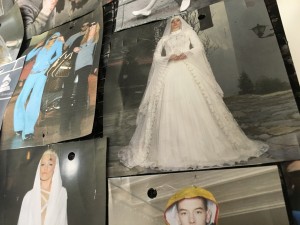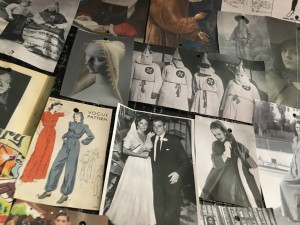Why we chose the hoodie:
We chose the hoodie, and specifically the hood aspect, because we wanted to explore the roots of its interesting shape, and ambiguous purpose.
TOTAL HOURS MAKING: approx. 21
MATERIALS USED: chicken wire, newspaper, liquid glue/water, wire, fishing wire/needle, photographs, hole punch, newsprint, black acrylic paint.
The purposes of a hoodie:
The hoodie’s purpose is to mainly protect in cold weather. The hood is also a sign of mourning or solitude. It is able to create a barrier, emotionally as well as physically. making it harder to see outside, and for the outside to see you.
We painted our walk-in hoodie black, in order to make it slightly a claustrophobic, cocoon-like space which reflect isolation and contemplation. When sitting in the space you are able to look around and see the visual evolution of the hood- the past above you and the present around you, (((replacing your peripheral vision with those images.)))
Origin
Hoodies trace far back visually from Tatami armour in Japan during the Edo period to monks in medieval times
Also used by inuits to keep warm in the arctic regions of canada and alaska, the hoods were usually lined with the fur of a wolf
They were also worn by the natives to what is called the Mi’kmaq region of canada
Medieval
Carmelite monks originally wore hoods to protect them from the cold in winter months,
These hoods also were a representation of them mourning for their own sins
Carmelite Holy Habits (what the monks wore) were brown and made of wool
During medieval times a headpiece referred to as the French Hood. It was worn by women during the tudor era but predominantly during the latter half (1500’s 1600’s)
This had a veil which was referred to as the hood of the headpiece which was worn back as a traditional custom.
And of course, peasantry wore the hood frequently to protect them as they worked physically outside.
Renaissance
Mary Queen of Scots, popularized French mourning hoods after the death of her husband in 1559.
The order of capuchin friars minor is an order of friars in the catholic church gave the capuccino its name, referring to the color of their monk habits which were a slightly lighter brown and hooded
The Tudor hats, caps and hoods are also during this time. Serving for fashion, religious conservatism, and protection of the hair.
In women’s fashion, the hood wasn’t used heavily. It was more of a combination of a veil and a hat, protecting and enhancing the woman’s head.
Enlightenment era (18th century)
They weren’t heavily popularized because of the usage of coiffeurs, however they were also used for outside protection through wraps rather than outerwear.
19th century
They were still used by monks.
In modern times, Bashlyks (a variation of the hoodie) became fashionable in Russia in 1830-1840, after the Napoleonic War by the Bashkir cavalry. By the 1862 bashlyks were made a uniform headdress in Cossack armies, and later in other branches of Russian armed forces.
>20/30s
Russell Athletics lays claim to the first sweatshirt, in 1920 to help football players’ discomfort from sweating in wool jerseys.
Champion Products, is widely credited as the creator of the first hooded sweatshirt, which was made to provide athletes and laborers, like cold-storage workers, added protection and warmth.
During WWII the hooded siren suit was used during nighttime air raids. It was a jumper that was easily put over your clothing. It was given its name because of the sirens which would sound at this time. Furthermore the siren suit was popularized and worn by many as a stylish item of clothing.
BUT, The hoodie made went from practicality to personal style when athletes started to give their track gear to their girlfriends to wear. Soon sportswear caught on as a fashionable style.
The KKK wore white hoods. It’s a variation which covered the entire head and face, bringing out an exaggerated awareness of the hoodies secrecy the triangle shape is similar to the shape of a typical hood.
>50s
Hoods were still used for athletic wear, but in women’s fashion the hood was large and grand to their outerwear. Mostly to ensure their hair was covered, but it also helped with a fashion statement.
>60s
It wasn’t extremely popular in this era, but was especially on outerwear.
>70s
The first people wearing the hoodie were a group of people in the background of urban culture: “stick-up-kids.” The stick-up-kids were essentially muggers who had good reason to conceal their identities. Even though the stick-up-kids were criminals, they were highly respected by some.
The ‘70s saw the hoodie’s transformation from a piece of clothing to a cultural symbol. At the time, New York City saw it began in street cultures, including hip hop. Graffiti artists, found the hoodie useful for concealing their identities while they “bombed” walls and buildings, linking the garment to illicit activity and what was then perceived as a defiant subculture. The graffiti writers used the hoodie to keep a low profile, they were inexpensive, and had an easy wash-and-wear, Break-dancers wore it “to keep their bodies warm before they hit the floor.”
In 1976, “Rocky” added another layer of symbolism to the hoodie with his hard knocks, hard work ethic, reestablishing its connection to its working class roots and cementing its prominence in mainstream culture.
The namesake hoodie pays homage to this moment in hoodie history.
>80s
In 1980, fashion designer Norma Kamali created her celebrated Sweatshirt Collection, which changed the fashion industry’s perception and use of everyday materials in high-end design.
Also, skaters adapted and skated wherever they could, legal or not. “By being a skater, you were sneaking around and trying to get into parking garages and the hood up was this way of masking your identity.
>90s
By the ‘90s, the hoodie’s duality as both trend and staple was well established. It’s during this era when the term hoodie becomes part of American vernacular, mostly because of hip hop’s rise into the mainstream.
The Nineties saw the emergence of especially hard-edged gangsta rap, and groups like Wu Tang Clan and Cypress Hill had a pared-down dress code to go along with their gritty attitudes.
Clothing designers such as Tommy Hilfiger and Ralph Lauren took note, finding inspiration in the fashion of the streets. They helped bring the hoodie full circle from the high schools to the streets and back again – though this time with a whole lot more cultural baggage.
21st century
At this point, hoodies are a “fashion right” to a particular look, mostly casual. It was popularized by the Juicy Couture Track Suit, and celebrities covering their face from the press. Hoodies were also layered differently, and under t-shirts instead of over. Hoodies can range from any layer: outerwear to first layer, to third layer.
Currently
In 2012, Mark Zuckerberg caused a stir when he chose to meet Wall Street investors wearing a hoodie in the months leading up to Facebook’s initial public offering. Whether seen as a statement or ploy, scrutiny about the hoodie and what it symbolizes were the subject of debate, with most concluding it had more to do with establishing an identity as a non-conformist than making a casual fashion statement.
The same year, Trayvon Martin was wearing a hoodie the night he was killed in Florida after being deemed “suspicious.” The tragic incident sparked a national dialogue surrounding perceptions about race, image, identity and class. The hoodie became a banner for supporters of Trayvon Martin.
And within this year, Vogue recognized that the hoodie becomes a swath of formal fabric that you can dress up with a pencil skirt. Mostly because of the Vetements sweatshirt that went along with Athleisure. So now hoodies can be anywhere from $10-$885
Future
Now everyone is trying to reinvent the purpose of the hoodie because of it being a staple to many garments. For example:
Sunglasses inside the hood, earbuds in the hood, hoodie pillow, hoodie with shapes and embroidery, hoodie with mask, hoodie for pets, hoodie holding pets, hoodie for babies, hoodie on formal dresses and wedding dress, etc.
OVERALL:
Design and Creative Director Orondava Mumford said, “Take a look around and you’ll see artists, athletes, innovators and entrepreneurs all wearing our hoodies. The hoodie and basics like tees and sweats have achieved uniform-status for the modern creative. Hoodies even carry a revolutionary spirit and sigma that’s constantly under discussion in politics and culture. It’s a mainstay we’re honored to keep evolving into the future.”
BIBLIOGRAPHY
https://en.wikipedia.org/wiki/Hoodie
http://www.rollingstone.com/culture/news/the-history-of-the-hoodie-20120403
https://www.washingtonpost.com/conversations/evolution-of-the-hoodie/2012/03/26/gIQAArvWcS_gallery.html
http://commonthread.alternativeapparel.com/moments-in-hoodie-history/
http://www.vogue.com/13412647/spring-2016-hoodie-trend/https://www.washingtonpost.com/blogs/blogpost/post/trayvon-martin-million-hoodie-march-a-short-history-of-the-hoodie/2012/03/22/gIQAeGCnTS_blog.html
https://books.google.com/books?id=mn9FeXHqvskC&pg=PA89&lpg=PA89&dq=mourning+hoods+in+18th+century&source=bl&ots=oRFw3U7GKW&sig=wK-KtS0aY0gh92vWWlvpYuvWs9w&hl=en&sa=X&ved=0ahUKEwjcoe30o8nLAhVEqx4KHTMPA_IQ6AEIKTAC#v=onepage&q=mourning%20hoods%20in%2018th%20century&f=false


